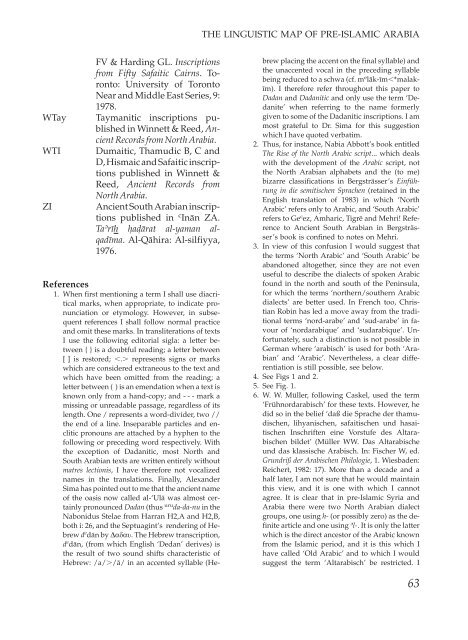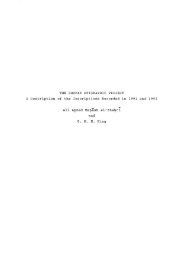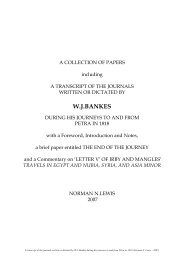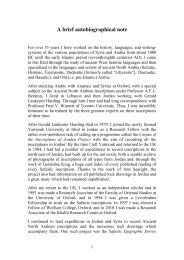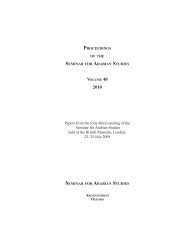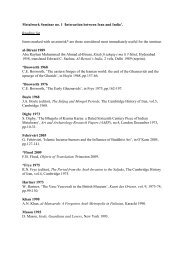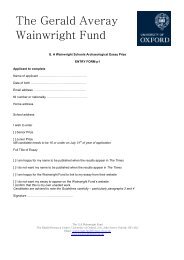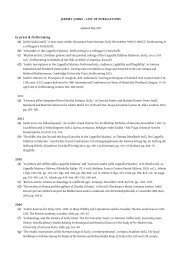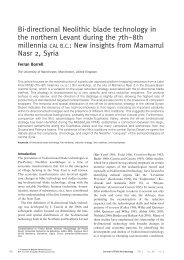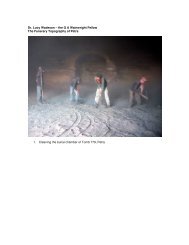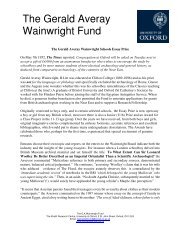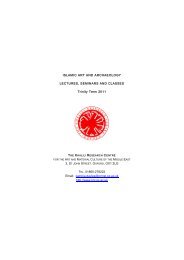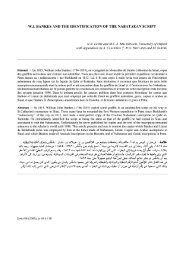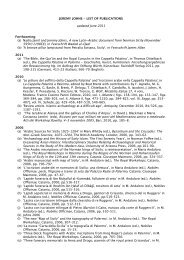Reflections on the linguistic map of pre-Islamic Arabia - Khalili ...
Reflections on the linguistic map of pre-Islamic Arabia - Khalili ...
Reflections on the linguistic map of pre-Islamic Arabia - Khalili ...
Create successful ePaper yourself
Turn your PDF publications into a flip-book with our unique Google optimized e-Paper software.
FV & Harding GL. Inscripti<strong>on</strong>s<br />
from Fifty Safaitic Cairns. Tor<strong>on</strong>to:<br />
University <strong>of</strong> Tor<strong>on</strong>to<br />
Near and Middle East Series, 9:<br />
1978.<br />
WTay Taymanitic inscripti<strong>on</strong>s published<br />
in Winnett & Reed, Ancient<br />
Records from North <strong>Arabia</strong>.<br />
WTI Dumaitic, Thamudic B, C and<br />
D,Hismaic andSafaitic inscripti<strong>on</strong>s<br />
published in Winnett &<br />
Reed, Ancient Records from<br />
North <strong>Arabia</strong>.<br />
ZI Ancient South <strong>Arabia</strong>n inscripti<strong>on</strong>s<br />
published in c Inān ZA.<br />
Ta $ rīh hw adw ārat al-yaman alqadīma.<br />
Al-Qāhira: Al-silfiyya,<br />
1976.<br />
References<br />
1. When first menti<strong>on</strong>ing a term I shall use diacritical<br />
marks, when appropriate, to indicate pr<strong>on</strong>unciati<strong>on</strong><br />
or etymology. However, in subsequent<br />
references I shall follow normal practice<br />
and omit <strong>the</strong>se marks. In transliterati<strong>on</strong>s <strong>of</strong> texts<br />
I use <strong>the</strong> following editorial sigla: a letter between<br />
{ } is a doubtful reading; a letter between<br />
[ ] is restored; ∞.± re<strong>pre</strong>sents signs or marks<br />
which are c<strong>on</strong>sidered extraneous to <strong>the</strong> text and<br />
which have been omitted from <strong>the</strong> reading; a<br />
letter between ( ) is an emendati<strong>on</strong> when a text is<br />
known <strong>on</strong>ly from a hand-copy; and - - - mark a<br />
missing or unreadable passage, regardless <strong>of</strong> its<br />
length. One / re<strong>pre</strong>sents a word-divider, two //<br />
<strong>the</strong> end <strong>of</strong> a line. Inseparable particles and enclitic<br />
pr<strong>on</strong>ouns are attached by a hyphen to <strong>the</strong><br />
following or <strong>pre</strong>ceding word respectively. With<br />
<strong>the</strong> excepti<strong>on</strong> <strong>of</strong> Dadanitic, most North and<br />
South <strong>Arabia</strong>n texts are written entirely without<br />
matres lecti<strong>on</strong>is, I have <strong>the</strong>refore not vocalized<br />
names in <strong>the</strong> translati<strong>on</strong>s. Finally, Alexander<br />
Sima has pointed out to me that <strong>the</strong> ancient name<br />
<strong>of</strong> <strong>the</strong> oasis now called al-‘Ulā was almost certainly<br />
pr<strong>on</strong>ounced Dadan (thus uru da-da-nu in <strong>the</strong><br />
Nab<strong>on</strong>idus Stelae from Harran H2,A and H2,B,<br />
both i: 26, and <strong>the</strong> Septuagint’s rendering <strong>of</strong> Hebrew<br />
d e dānbyDadau. The Hebrew transcripti<strong>on</strong>,<br />
d e dān, (from which English ‘Dedan’ derives) is<br />
<strong>the</strong> result <strong>of</strong> two sound shifts characteristic <strong>of</strong><br />
Hebrew: /a/±/ā/ in an accented syllable (He-<br />
THE LINGUISTIC MAP OF PRE-ISLAMIC ARABIA<br />
brew placing <strong>the</strong> accent <strong>on</strong> <strong>the</strong> final syllable) and<br />
<strong>the</strong> unaccented vocal in <strong>the</strong> <strong>pre</strong>ceding syllable<br />
being reduced to a schwa (cf. m e lāk-īm∞*malakīm).<br />
I <strong>the</strong>refore refer throughout this paper to<br />
Dadan and Dadanitic and <strong>on</strong>ly use <strong>the</strong> term ‘Dedanite’<br />
when referring to <strong>the</strong> name formerly<br />
given to some <strong>of</strong> <strong>the</strong> Dadanitic inscripti<strong>on</strong>s. I am<br />
most grateful to Dr. Sima for this suggesti<strong>on</strong><br />
which I have quoted verbatim.<br />
2. Thus, for instance, Nabia Abbott’s book entitled<br />
The Rise <strong>of</strong> <strong>the</strong> North Arabic script... which deals<br />
with <strong>the</strong> development <strong>of</strong> <strong>the</strong> Arabic script, not<br />
<strong>the</strong> North <strong>Arabia</strong>n alphabets and <strong>the</strong> (to me)<br />
bizarre classificati<strong>on</strong>s in Bergsträsser’s Einführung<br />
in die semitischen Sprachen (retained in <strong>the</strong><br />
English translati<strong>on</strong> <strong>of</strong> 1983) in which ‘North<br />
Arabic’ refers <strong>on</strong>ly to Arabic, and ‘South Arabic’<br />
refers to Ge c ez, Amharic, Tigrē and Mehri! Reference<br />
to Ancient South <strong>Arabia</strong>n in Bergsträsser’s<br />
book is c<strong>on</strong>fined to notes <strong>on</strong> Mehri.<br />
3. In view <strong>of</strong> this c<strong>on</strong>fusi<strong>on</strong> I would suggest that<br />
<strong>the</strong> terms ‘North Arabic’ and ‘South Arabic’ be<br />
aband<strong>on</strong>ed altoge<strong>the</strong>r, since <strong>the</strong>y are not even<br />
useful to describe <strong>the</strong> dialects <strong>of</strong> spoken Arabic<br />
found in <strong>the</strong> north and south <strong>of</strong> <strong>the</strong> Peninsula,<br />
for which <strong>the</strong> terms ‘nor<strong>the</strong>rn/sou<strong>the</strong>rn Arabic<br />
dialects’ are better used. In French too, Christian<br />
Robin has led a move away from <strong>the</strong> traditi<strong>on</strong>al<br />
terms ‘nord-arabe’ and ‘sud-arabe’ in favour<br />
<strong>of</strong> ‘nordarabique’ and ‘sudarabique’. Unfortunately,<br />
such a distincti<strong>on</strong> is not possible in<br />
German where ‘arabisch’ is used for both ‘<strong>Arabia</strong>n’<br />
and ‘Arabic’. Never<strong>the</strong>less, a clear differentiati<strong>on</strong><br />
is still possible, see below.<br />
4. See Figs 1 and 2.<br />
5. See Fig. 1.<br />
6. W. W. Müller, following Caskel, used <strong>the</strong> term<br />
‘Frühnordarabisch’ for <strong>the</strong>se texts. However, he<br />
did so in <strong>the</strong> belief ‘daß die Sprache der thamudischen,<br />
lihyanischen, safaitischen und hasaitischen<br />
Inschriften eine Vorstufe des Altarabischen<br />
bildet’ (Müller WW. Das Altarabische<br />
und das klassische Arabisch. In: Fischer W, ed.<br />
Grundriß der Arabischen Philologie, 1. Wiesbaden:<br />
Reichert, 1982: 17). More than a decade and a<br />
half later, I am not sure that he would maintain<br />
this view, and it is <strong>on</strong>e with which I cannot<br />
agree. It is clear that in <strong>pre</strong>-<strong>Islamic</strong> Syria and<br />
<strong>Arabia</strong> <strong>the</strong>re were two North <strong>Arabia</strong>n dialect<br />
groups, <strong>on</strong>e using h- (or possibly zero) as <strong>the</strong> definite<br />
article and <strong>on</strong>e using $ l-. It is <strong>on</strong>ly <strong>the</strong> latter<br />
which is <strong>the</strong> direct ancestor <strong>of</strong> <strong>the</strong> Arabic known<br />
from <strong>the</strong> <strong>Islamic</strong> period, and it is this which I<br />
have called ‘Old Arabic’ and to which I would<br />
suggest <strong>the</strong> term ‘Altarabisch’ be restricted. I<br />
63


